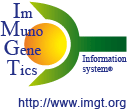KIR and LILR/ILT receptors
KIR: Killer cell Immunoglobulin-like Receptor, MHC class I receptors expressed by NK cells and a subpopulation of T cells.
The human leukocyte receptor complex (LCR) is a genetic region of at least 1MB on chromosome 19 at 19q13.4 which contains genes encoding the KIR responsible for inhibiting the innate cytotoxic activity of NK lymphocytes.
The LILR/ILT/LIR [1] which have
- homology to the KIRs but with a more widespread cellular distribution and are expressed on a variety of hematopoietic cell types including NK, T and B lymphocytes as well as myelomonocytic cells such as macrophages, mast cells, and dendritic cells
- additional proteins with related structure, function, and expression, such as LAIR-1 and FcαR.
The KIR and LILR/ILT/LIR protein families are structurally and functionally comparable. Both:
- have similar extracellular regions comprising C-LIKE-DOMAINs: two or three for KIR, two or four for LILR/ILT/LIR.
- possess isoforms with different cytoplasmic signalling functions. KIR and LILR/ILT/LIR receptors with long cytoplasmic tails inhibit cellular activation through recruitment of SHP-1 phosphatase to the ITIM motifs. KIR and LILR/ILT/LIR receptors with short cytoplasmic tails transmit activation signals via a charged residue in their transmembrane region associated with signalling adaptor proteins possessing ITAM motifs (TYROBP/DAP-12).
Despite these similarities, the KIR and LILR/ILT/LIR receptors have distinct functional characteristics. Whereas most KIR recognize discrete polymorphic epitopes within the G-ALPHA-1 of HLA class I, only the LILR1/ILT2 and LILR2/ILT4 receptors have been demonstrated to bind to a variety of HLA class I ligands. The binding of LILR1/ILT2 is probably mediated via a site in the conserved C-LIKE-DOMAIN of the HLA class I.
Mice do not possess KIR genes, but a locus on mouse chromosome 7 (syntenic to human 19q13) contains PIR genes with sequence homology to the human ILT/LIR genes.
[1] Young, N.T. et al., Immunogenetics, 53, 270-278 (2001).
- Les motifs ITIM
- NK Cell receptors
- Récepteurs des cellules NK ayant un domaine de type lectine : récepteurs NKG (12p13.2) (IMGT Education > Tutorials)
- Récepteurs des cellules NK ayant des domaines Ig-like : KIR (19q13.42) (IMGT Education > Tutorials)
- Nomenclature of the Leucocyte Receptor Complex (LRC) genes: LILR/ILT and KIR (19q13.42) (IMGT Education > Tutorials)



